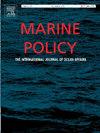The commitment of the EU Biodiversity Strategy for 2030 is unfeasible for marine threatened species affected by invasive alien species
IF 3.5
2区 社会学
Q2 ENVIRONMENTAL STUDIES
引用次数: 0
Abstract
The paper examines the feasibility of achieving the ambitious quantitative commitment stated in the EU Biodiversity Strategy for 2030 “a 50 % reduction in the number of Red List species threatened by invasive alien species” concerning marine species. The limited knowledge base and poor confidence in the evidence concerning impacts of IAS in the marine realm, and the complexity of multiple stressors affecting marine biota, pose major challenges to achieving the management goal. Specifically, i) assessments of IAS impacts in European seas were available only for 73 % of the investigated Red List species (RLS; Critically Endangered, Endangered, Near Threatened, and Vulnerable), ii) for 40 % of the assessed RLS (in Europe or globally) the threat/severity impact posed by IAS remains to be fully assessed, and iii) threat/harm-posing IAS were identified at the species level only in 64 % cases. Overall, the i) relative IAS impact compared to other threats, ii) certainty of IAS impact evidence, iii) IAS control potential, and iv) potential for reducing threat category of RLS following IAS management remain low. Given the generally poor knowledge base on IAS impacts on the RLS inhabiting European seas (irrespective of the EU boundaries), we advocate a re-examination of the available data augmented with targeted studies to support management actions. While the 50 % reduction of RLS threatened by IAS, as laid out by the EU Biodiversity Strategy for 2030, via direct management of these IAS is unfeasible, addressing other evidence-based threats to reduce the pressure on RLS should be considered.
求助全文
约1分钟内获得全文
求助全文
来源期刊

Marine Policy
Multiple-
CiteScore
7.60
自引率
13.20%
发文量
428
期刊介绍:
Marine Policy is the leading journal of ocean policy studies. It offers researchers, analysts and policy makers a unique combination of analyses in the principal social science disciplines relevant to the formulation of marine policy. Major articles are contributed by specialists in marine affairs, including marine economists and marine resource managers, political scientists, marine scientists, international lawyers, geographers and anthropologists. Drawing on their expertise and research, the journal covers: international, regional and national marine policies; institutional arrangements for the management and regulation of marine activities, including fisheries and shipping; conflict resolution; marine pollution and environment; conservation and use of marine resources. Regular features of Marine Policy include research reports, conference reports and reports on current developments to keep readers up-to-date with the latest developments and research in ocean affairs.
 求助内容:
求助内容: 应助结果提醒方式:
应助结果提醒方式:


